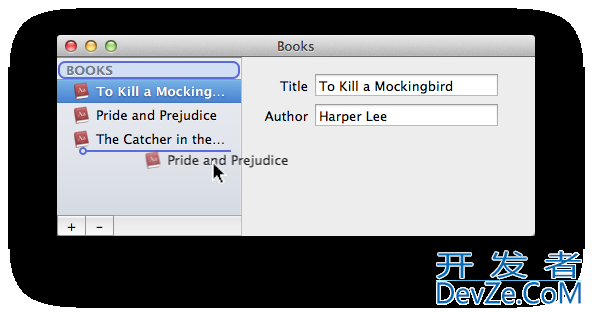Binding view-based NSOutlineView to Core Data
I'm trying to implement the new view-based OutlineView as a source list in my Mac app. I can't get values to display, though, so I made a small test app from the Core Data app template, and can't get it working right in there, either.
I defined two simple classes in my data model; let's call them "Parent" and "Child". Parent has a single Attribute, "name", and a single relationship, "children". name is an optional string, and children is an optional to-many relationship to Child. Child has the same "name" attribute and a to-one "parent" relationship that is the inverse of children. I generated custom 开发者_开发百科classes for both of those, and wrote a stub in Child for children that returns nil.
I dragged a Source List from the Object library onto my XIB, and dropped in a Tree Controller. The Tree Controller's Children Key Path is set to "children", it's in Entity Name mode, with "Parent" as the Entity Name, Prepares Content checked, and its Managed Object Context set to the app delegate's context. The Tree Controller is the data source of the outline view, and I bound the data cell's text view to Table Cell View, with the "objectValue.name" key path.
in -applicationDidFinishLaunching: I create two Parent instances, one with a Child, and assign the name property of every object.
The actual problem

Now, with that setup out of the way, I get rows showing up in the source list, but the text fields are empty, even though they're bound. I don't think I should need to do anything else, since I'm using bindings, and I'm fairly certain binding to the objectValue property is the right thing. What's going wrong?
I can provide more detail if necessary, but I'm pretty sure that covers everything I did.
Wow, it's like me from two weeks ago is asking this question.
Anyway, if you're anything like me, the problem is that,
for view-based NSOutlineViews, you need to implement the
- (NSView *)outlineView:(NSOutlineView *)outlineView
viewForTableColumn:(NSTableColumn *)tableColumn
item:(id)item;
delegate method and return the NSTableCellView you set up,
or they'll just give you a blank line. The easiest way to do this is to just call
[outlineView makeViewWithIdentifier:@"MyCell" owner:self]
replacing MyCell with whatever you typed in as the "User Interface Item Identifier"
in the Identity Inspector for your NSTableCellView.
Objective-C:
- (NSView *)outlineView:(NSOutlineView *)outlineView viewForTableColumn:(NSTableColumn *)tableColumn item:(id)item {
return [outlineView makeViewWithIdentifier:@"MyCell" owner:self];
}
Swift:
func outlineView(_ outlineView: NSOutlineView, viewFor tableColumn: NSTableColumn?, item: Any) -> NSView? {
return outlineView.makeView(withIdentifier: NSUserInterfaceItemIdentifier("MyCell"), owner: self)
}
UPDATE 2018-08-02:
Actually, you don't need to set the delegate. Here is how I got it working (tested with NSTreeController, but should work with NSArrayController as well):
- Bind each column object to
arrangedObjects(without Model Key Path) - Bind the inner-most custom view (e.g., label field) to
objectValue.yourCustomValue - Shouldn't be necessary but if this doesn't work try setting the identifier for the column and for the
TableCellView. Make sure both identifiers are identical. Repeat that for the remaining columns with different identifiers.
Screenshot: Bindings for View Based NSOutlineView
As Boaz noted above, you need to implement the Delegate method to return a view.
Quite a mystery considering I could not find that method in the Docs.
Regarding the type of the (id)item parameter, it's a NSTreeControllerTreeNode which is an undocumented subclass of NSTreeNode. If you cast it you can get the cell's object, and return different view based what kind of object is, or whatever attributes of that object determine the cell view type:
- (NSView *)outlineView:(NSOutlineView *)outlineView viewForTableColumn:(NSTableColumn *)tableColumn item:(id)item {
NSTableCellView *view = nil;
NSTreeNode *node = item;
if ([node.representedObject isKindOfClass:[Group class]]) {
view = [outlineView makeViewWithIdentifier:@"HeaderCell" owner:self];
} else {
view = [outlineView makeViewWithIdentifier:@"DataCell" owner:self];
}
return view;
}
This appeared to be a change for Xcode 4 or thereabouts. Interface builder adds two NSTableCellView objects under the NSOutlineView. If you delete the NSTableCellView objects you return to a saner (or at least documented) world where you need would implement the methods:
outlineView:dataCellForTableColumn:item
outlineView:willDisplayCell:forTableColumn:item
...or at least you do if you want a source list look. In any case this is how the SourceView sample is setup and is why, when you try to recreate the SourceView sample that you can get in such a mess.
Alternatively if you want to continue to use the NSTableCellView objects (which are quite useful) then you can:
bind the NSOutlineView 'Content' to your TreeController.arrangedObjects
bind the NSTextField (and/or NSImageView) under NSTableCellView to 'Table Cell View' with a model key path of objectValue.< key >
I have created a little sample project which popuplates also popuplates an NSOutlineView, not with CoreData but the crucial factor is, like @boaz-stuller stated that the correct cell is selected (similar to how you handle UITableViewCells in iOS.
So in my case I have implemented the method like so:
- (NSView *)outlineView:(NSOutlineView *)outlineView viewForTableColumn:(NSTableColumn *)tableColumn item:(id)item {
if ([self isHeader:item]) {
return [outlineView makeViewWithIdentifier:@"HeaderCell" owner:self];
} else {
return [outlineView makeViewWithIdentifier:@"DataCell" owner:self];
}
}
Check out besi/mac-quickies on github. Most of the stuff is either done in IB or can be found in the AppDelegate

 加载中,请稍侯......
加载中,请稍侯......
精彩评论